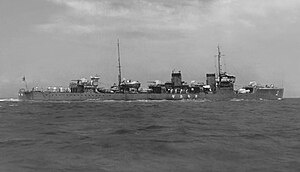Japanese destroyer Okikaze

Okikaze at Yokosuka, 1932
|
|
| History | |
|---|---|
|
|
|
| Name: | Okikaze |
| Ordered: | fiscal 1917 |
| Builder: | Maizuru Naval Arsenal |
| Laid down: | 22 February 1919 |
| Launched: | 3 October 1919 |
| Commissioned: | 17 August 1920 |
| Struck: | 1 March 1944 |
| Fate: | Sunk in action, 10 January 1943 |
| General characteristics | |
| Class and type: | Minekaze-class destroyer |
| Displacement: |
|
| Length: |
|
| Beam: | 9 m (30 ft) |
| Draught: | 2.8 m (9.2 ft) |
| Propulsion: | 2-shaft Mitsubishi-Parsons geared turbines, 4 boilers 38,500 ihp (28,700 kW) |
| Speed: | 39 knots (72 km/h) |
| Range: | 3,600 nautical miles (6,700 km) at 14 knots (26 km/h) |
| Complement: | 148 |
| Armament: |
|
| Service record | |
| Operations: | |
The Japanese destroyer Okikaze (沖風 Offshore Wind?) was one of 15 Minekaze-class destroyers built for the Imperial Japanese Navy during the late 1910s. The ship served as a plane guard and played a minor role in the First Shanghai incident during the 1930s. She spent most of the Pacific War on escort duties in Japanese waters until she was sunk by an American submarine in early 1943.
The Minekaze class was designed with higher speed and better seakeeping than the preceding Kawakaze-class destroyers. The ships had an overall length of 102.5 meters (336 ft 3 in) and were 94.5 meters (310 ft 0 in) between perpendiculars. They had a beam of 9.04 meters (29 ft 8 in), and a mean draft of 2.9 meters (9 ft 6 in). The Minekaze-class ships displaced 1,366 metric tons (1,344 long tons) at standard load and 1,676 metric tons (1,650 long tons) at deep load. They were powered by two Parsons geared steam turbines, each driving one propeller shaft, using steam provided by four Kampon water-tube boilers. The turbines were designed to produce 38,500 shaft horsepower (28,700 kW), which would propel the ships at 39 knots (72 km/h; 45 mph). The ships carried 401 metric tons (395 long tons) of fuel oil which gave them a range of 3,600 nautical miles (6,700 km; 4,100 mi) at 14 knots (26 km/h; 16 mph). Their crew consisted of 148 officers and crewmen.
...
Wikipedia
